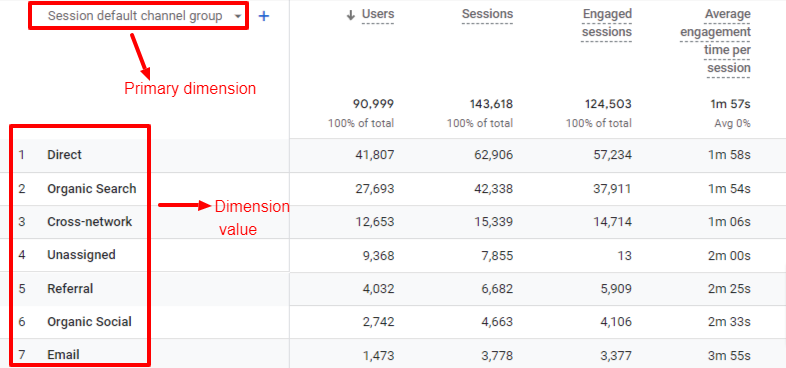Take Full Advantage Of Coverage Precision With Second Dimension in Google Analytics
Understanding just how to take full advantage of reporting accuracy with second measurements in Google Analytics can dramatically boost the deepness of insights derived from information analysis. By including second measurements strategically, marketing professionals can uncover surprise patterns and connections that might not be right away obvious when analyzing key metrics alone. This nuanced approach allows an extra detailed understanding of individual habits and project efficiency, paving the means for more targeted and reliable decision-making. The utilization of additional measurements holds the crucial to opening a wide range of important info that can change the performance of digital marketing strategies.
Comprehending Second Measurements in Google Analytics
Secondary dimensions permit individuals to section and additionally study information past the main measurement chosen. While the primary dimension might present the total number of web page views, adding a secondary dimension such as 'source/medium' can offer insights right into where the traffic originated from.
In addition, comprehending secondary dimensions is vital for developing more customized records tailored to specific service objectives. By picking the right mix of additional and key measurements, experts can discover patterns, patterns, and connections that might or else stay hidden. This nuanced technique to data evaluation encourages businesses to make informed choices based upon a detailed understanding of user habits across different measurements.

How to Use Secondary Dimensions
When leveraging second dimensions in Google Analytics, the functional application includes selecting specific data parameters to further improve insights beyond the primary measurement's scope. To use secondary dimensions successfully, begin by accessing the record or dataset where you want to dig deeper right into the information. Within Google Analytics, locate the primary measurement that you are currently evaluating. When determined, click the dropdown menu labeled "Secondary Measurement." This activity will certainly disclose a listing of additional criteria that can be included in your analysis. Pick the secondary dimension that lines up with your analytical goals, such as 'Source/Medium,' 'Tool Category,' or 'Place.' By choosing a second measurement, you can gain extra in-depth understandings right into individual behavior, demographics, or acquisition networks. Keep in mind that additional measurements assist supply context and granularity to your main measurement information, allowing you to remove more purposeful and workable insights from your Google Analytics records.
Leveraging Secondary Dimensions for Insights
Utilizing second dimensions in Google Analytics enables an extra detailed analysis of data, offering valuable understandings past the main measurement's extent. By leveraging additional measurements, customers can dive deeper into the performance metrics of their internet site or application, discovering covert patterns and patterns that might not be quickly evident when only taking a look at primary dimensions.
One trick advantage of using additional dimensions is the ability to section and filter information a lot more exactly. This can aid marketing experts and experts much better recognize the habits of details individual sectors, such as brand-new visitors versus returning site visitors, or traffic coming from different geographic locations.
Furthermore, secondary measurements allow customers to compare and comparison different data factors within the exact same record, supplying a more alternative view of efficiency (Secondary Dimension in Google Analytics). As an example, pairing the main measurement of landing web pages with second measurements like demographics or tools can browse around here expose which pages are most efficient in involving individuals on different gadgets or from different market groups.
Essentially, leveraging additional measurements in Google Analytics equips individuals to extract richer insights from their information, causing even more educated decision-making and inevitably, enhanced efficiency.
Best Practices for Additional Dimensions
When assessing data in Google Analytics, including secondary dimensions properly improves the depth of understandings derived from the key metrics. Choosing appropriate secondary dimensions assists in providing context and a clearer understanding of the data being analyzed.
Moreover, it is recommended to restrict the number of secondary measurements used in a solitary report to stay clear of frustrating the evaluation with way too much information. Concentrating on a few essential additional dimensions at a time can bring about even more concentrated and actionable insights. In addition, think about trying out different mixes of secondary and main dimensions to discover unique trends and patterns that may not be noticeable when looking at the data in isolation.
Advanced Analysis Strategies With Secondary Measurements
Checking out complex information partnerships via the critical application of secondary measurements can unveil nuanced understandings that elevate the depth of analysis in Google Analytics. By incorporating additional dimensions with main data collections, advanced analysis methods can be used to draw out important information.
In addition, second dimensions can boost the analysis of conversion courses by offering added context. Comprehending the numerous touchpoints an individual connects with prior to transforming can be vital in maximizing the consumer trip - Secondary Dimension in Google Analytics. By making use of second measurements to dive right into specifics such as website traffic resources or visit homepage devices made use of, marketing professionals can customize approaches to target high-converting networks properly
Conclusion

To boost information evaluation and gain deeper insights right into individual behavior, recognizing second dimensions check my blog in Google Analytics is necessary - Secondary Dimension in Google Analytics. Secondary dimensions allow customers to sector and even more study information beyond the main dimension chosen. While the key measurement may show the complete number of page sights, including a second measurement such as 'source/medium' can offer understandings right into where the website traffic stemmed from.When leveraging second dimensions in Google Analytics, the sensible application involves picking certain data criteria to more improve insights past the key dimension's scope. Bear in mind that secondary measurements assist offer context and granularity to your key measurement data, enabling you to remove more purposeful and actionable insights from your Google Analytics reports